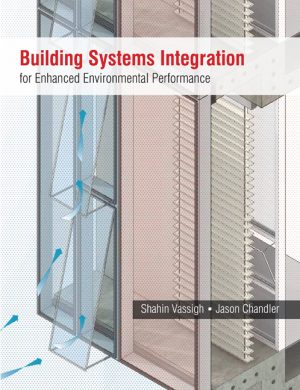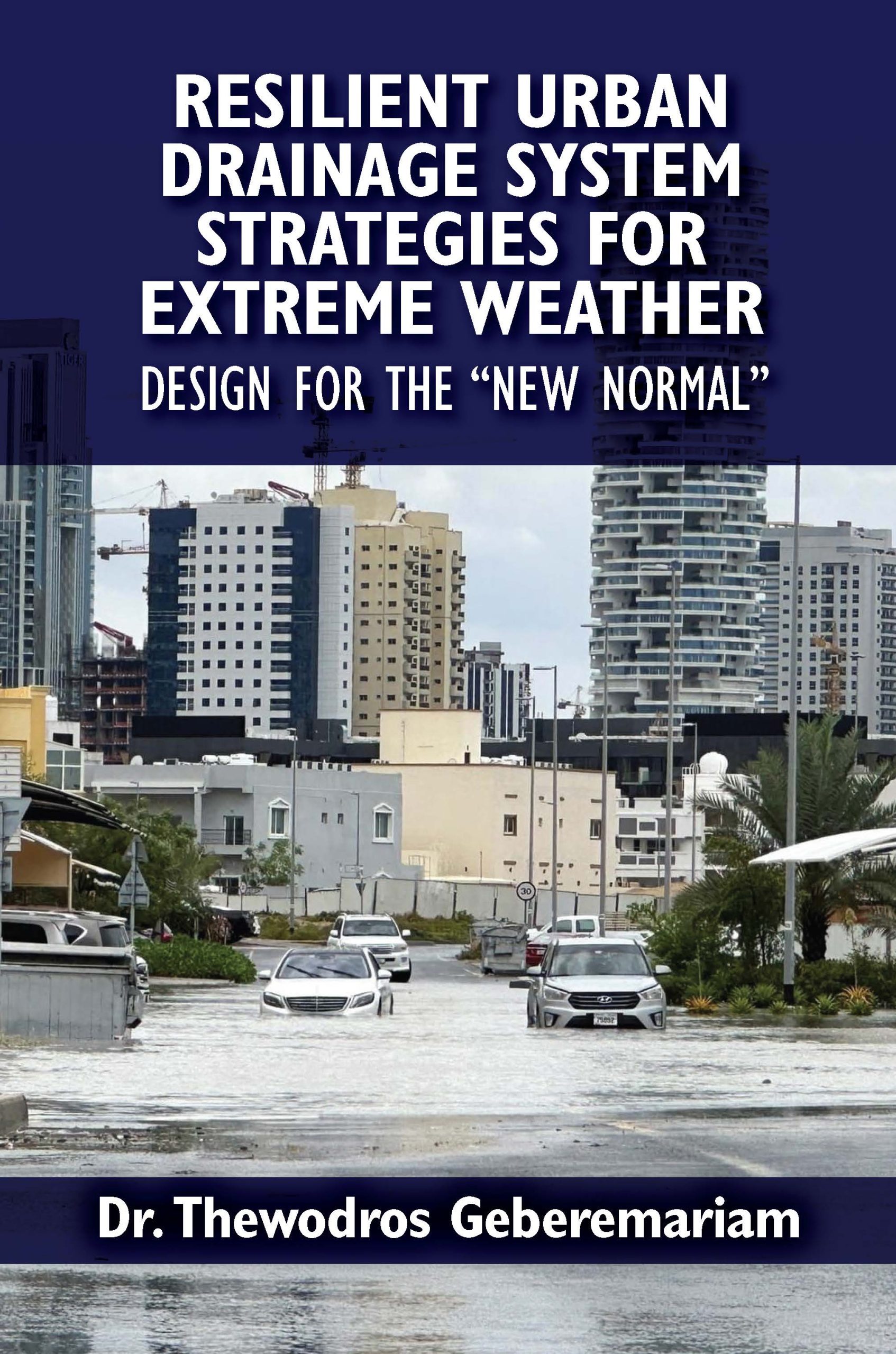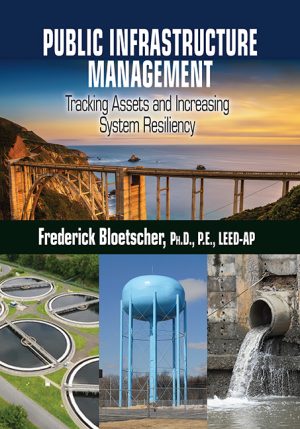Resilient Urban Drainage System Strategies for Extreme Weather
$89.95
Design for the “New Normal”
Thewodros Geberemariam, Ph.D., P.E.
Hardcover, 6×9, 300 pages
ISBN: 978-1-60427-204-8
e-ISBN: 978-1-60427-858-3
October 2024
Description
Existing urban drainage infrastructure is heavily reliant on current guidelines that govern how infrastructure systems are designed to withstand the potential risk of flooding. However, climate change and an increase in the frequency and intensity of extreme weather events have cast doubt on the current methodology and standards for designing urban drainage infrastructure systems.
This groundbreaking book, authored by a leading expert in the field, delves into the crucial intersection of urban planning, climate resilience, and infrastructure design. It navigates the complexities of adapting drainage systems to cope with the increasing frequency and intensity of extreme weather events. From torrential downpours to rising sea levels, the book offers innovative solutions tailored to the unique challenges faced by urban environments in the 21st century.
Through meticulous research and practical insights, Resilient Urban Drainage System Strategies for Extreme Weather equips engineers, planners, and policymakers with the knowledge and tools necessary to fortify cities against the impacts of climate change. This book showcases best practices and cutting-edge technologies, empowering readers to implement resilient strategies that safeguard communities, infrastructure, and natural ecosystems. Whether you’re a seasoned professional seeking advanced techniques or a newcomer eager to understand the evolving landscape of urban resilience, this guide is an indispensable resource for shaping a sustainable future in an era of unprecedented environmental challenges.
Key Features
- Promotes the concept of resilient urban drainage system solutions to bridge the critical design gap related to extreme weather due to climate change in the “New Normal” era
- Discusses a variety of strategic design approaches for large-scale drainage systems, including fail-safe, safe-to-fail, and robust decision making (RDM)
- Incorporates failure effects into design and management processes while demonstrating alternative solutions to supplement current design methodologies
- Demonstrates how low-impact development techniques and natural systems can be used to enhance current drainage systems
- Supplements the existing drainage system design criteria for extreme weather via a simplified approach and advancement of a multi-scalar perspective on resilience
- WAV offers instructional material for classroom use (lecture slides, exercise solutions, etc.)—available from the Web Added Value Download Resource Center at www.jrosspub.com/wav
About the author(s)
Thewodros K. Geberemariam, Ph.D., P.E., D. WRE, BCEE, has over 25 years of extensive experience in urban infrastructure and water resources engineering. His expertise is designing, analyzing, modeling, and evaluating urban drainage systems and flood control structures. He has been responsible for designing major and minor stormwater drainage conveyance systems, as well as water, sewer, and street improvement projects. He holds a Ph.D. and M.Sc. in Civil Engineering with a specialization in Urban Infrastructure and Water Resources Engineering from the New York University Tandon School of Engineering and the National University School of Engineering and Computing, respectively.
Thewodros is a licensed professional engineer in California and New York. He is also a Board-Certified Environmental Engineer (BCEE) and has been recognized as a Diplomate Water Resources Engineer (D. WRE) by the American Academy of Water Resources Engineers, a Division of ASCE. He is an ACEC-certified expert witness in surface water hydrology and hydraulics.
Thewodros has published more than 50 works on computational and Stochastic modeling, forecasting, asset management, hydrology, hydraulics analysis, and mathematical optimization in ASCE and other journals. He served as a peer reviewer and a technical advisor for the American Society of Civil Engineers on a number of task committees and as a lead technical expert on a wide array of water resources projects, ranging from hydrology and hydraulics analysis, stormwater system design and management, flood plain mapping, bridge hydraulics, culvert design, water reservoirs/dams to National Pollutant Discharge Elimination System permitting and water quality. He also consults on domestic and international water resources engineering projects.
Table of Contents
CHAPTER 1: PURPOSE AND SCOPE
1.1 Introduction
1.2 Design for the “New Normal”
1.3 Objectives
1.4 Distinctive Features of the Book
CHAPTER 2: EXTREME WEATHER DUE TO CLIMATE CHANGE
2.1 Introduction
2.2 Modeling Climate Change
2.2.1 The Process of Formulating Climate Change Scenarios
2.2.2 Analysis of Flooding and Disaggregation of Rainfall
2.2.3 Statistical Downscaling
2.2.4 Methods Using Empirical Transfer Functions
2.2.5 Strategies for Weather Typing or Resampling
2.2.6 Stochastic Models for Rainfall
2.2.7 Variability in Hydrology
2.3 Uncertainties in the Analysis of Climate Change Effects
2.3.1 Climate Variability and Prediction Uncertainties
2.4 Factors Accelerating Effects on Urban Drainage Systems
2.5 Climate Change and Flooding Due to Extreme Weather Events or the “New Normal”
2.5.1 How Global Warming Affects Precipitation
2.5.2 Rainfall Analysis
2.6 Average Rainfall Calculations
2.6.1 Estimating Missing Rainfall Data
2.6.2 Depth-Area-Duration Relation
2.7 Incorporating Extreme Weather in Urban Drainage Systems
2.7.1 Extreme Event Probabilities
2.7.2 Analysis of Rainfall Data Using Statistical Methods
2.7.3 Expected Rainfall Depths for a Given Probability
2.7.4 Probability of Exceedance
2.7.5 Recurrence Interval
2.7.6 Probability of Exceedance for Design Purposes
2.8 Plotting Position
2.8.1 Empirical Method
2.9 Theory of Extreme Value
2.9.1 Background
2.9.2 Generalized Extreme Value versus Generalized Pareto
2.9.3 Stationarity versus Nonstationarity in the Field of Data Analysis
2.10 Chapter Summary
2.11 Chapter Problems
Selected Sources and References
CHAPTER 3: FUNDAMENTALS OF URBAN DRAINAGE CONVENIENCE SYSTEMS
3.1 Introduction
3.1.1 The Evolution of Urban Drainage Systems
3.1.2 Exploring Ancient Urban Drainage Systems
3.1.3 Urban Drainage Systems in the Roman Empire
3.1.4 Post-Roman Empire Drainage System
3.1.5 Large-scale Drainage Systems in North America
3.1.6 Modern Development of Large-scale Drainage Systems
3.1.7 Current Urban Drainage Practices
3.1.8 Urban Drainage System—Emerging Trends and Innovations
3.1.9 Recognizing the Importance of Stormwater Management
3.1.10 Principles of Urban Storm Management
3.1.11 Managing Stormwater Runoff Effectively
3.1.12 Threat Presented by Insufficient Stormwater Management
3.1.13 Overcoming Challenges to Improve Stormwater Management for the “New Normal”
3.2 Urban Drainage Systems
3.2.1 Minor Stormwater Runoff Convenience Systems
3.2.2 Surface Drainage Convenience Systems
3.2.3 Underground Drainage Convenience Systems
3.2.4 Major Drainage Systems
3.2.5 Overland Stormwater Runoff Discharge Controls
3.2.6 Overland Stormwater Quality Controls
3.3 Basics of Stormwater Convenience System Design
3.3.1 The Project Site Development Process
3.3.2 Site Survey and Analysis
3.3.3 Hydrology and Hydraulic Analysis
3.3.4 Design Flood Frequency (Return Period–Years)
3.4 Time of Concentration and Travel Time
3.4.1 Methods for Calculating Time of Concentration
3.4.2 Methods for Calculating Stormwater Flow Velocity
3.5 Calculating Peak Discharge Rate and Hydrograph
3.5.1 Rational Method
3.5.2 Modified Rational Method—Flow Routing
3.5.3 NRCS or SCS Unit Hydrograph Method
3.6 Chapter Summary
3.7 Chapter Problems
Selected Sources and References
CHAPTER 4: RESETTING URBAN DRAINAGE SYSTEM DESIGN CRITERIA FOR THE “NEW NORMAL”
4.1. Introduction
4.1.1 Interaction between Major and Minor Drainage Systems
4.2 Overview of Current Urban Drainage System Designs and Planning Approaches
4.2.1 Challenges with Conventional Urban Drainage System Designs and Planning
4.3 Planners, Designers, and Stakeholders in Extreme Weather-Based Design Standards
4.3.1 Stakeholder Engagement
4.3.2 Collaboration with Government Entities
4.3.3 Addressing Current Vulnerability and Risk
4.3.4 Planning
4.3.5 Rules and Regulations
4.3.6 Insurance
4.4 Adapting Drainage Design Guidelines to Climate Change
4.4.1 Extreme Rainfall Event Management in Urban Areas
4.4.2 Design Return Intervals in Nonstationary Conditions
4.4.3 Stationary and Nonstationary Flood-Frequency Analysis
4.4.5 Generalized Extreme Value (GEV) Model for Stationary and Nonstationary Flood-Frequency Analysis
4.4.5 Retrofitting Existing Drainage Systems
4.5 Chapter Summary
4.6 Chapter Problems
Selected Sources and References
CHAPTER 5: SUPPLEMENTING URBAN DRAINAGE SYSTEM DESIGN CRITERIA TO ACCOMMODATE THE “NEW NORMAL”
5.1 Introduction
5.1.1 Infrastructure in a Nonstationary Climate
5.1.2 Understanding Urban Drainage Infrastructure Failures
5.2 Fail-Safe and Safe-to-Fail Drainage System Design Concepts
5.2.1 Safe‐to‐Fail Urban Drainage Infrastructure Development for the “New Normal”
5.2.2 Safe-to-Fail Decision Criteria to Control or Minimize the Consequences of Drainage Infrastructure Failure
5.3 Scenario-Based Robust Decision Making (RDM)
5.3.1 Application of Scenario-Based Robust Decision Making to the “New Normal”
5.3.2 Calculating Scenario-Based Robustness Metrics
5.3.3 Scenario-Based Robustness Metrics Framework
5.4 Robust Solution Analysis and Interpretation
5.5 Chapter Summary
5.6 Chapter Problems
Selected Sources and References
CHAPTER 6: EVALUATING CRITICAL DRAINAGE INFRASTRUCTURE’S RESILIENCE TO EXTREME WEATHER
6.1 Introduction
6.2 Risk-of-Failure Categorization
6.3 Risk-of-Failure Space Development
6.4 Basic Critical Drainage Area Resilience Assessment
6.5 Indicators
6.5.1 Reliability Indicators
6.5.2 Resilience Indicators
6.5.3 Sustainability Indicators
6.6. Reliability, Resilience, and Sustainability Robustness Indices
6.7. Trade-off between Cost, Resilience Enhancement, and Option Identification
6.7.1 Take No Action/Do Nothing, Do the Minimum, or Do Something
6.7.2 Cost-Benefit Analysis
6.7.3 Cost-Effectiveness Analysis
6.7.4 Multi-Criteria Analysis
6.8 Chapter Summary
6.9 Chapter Problems
Selected Sources and References
Index
Reviews
“I thoroughly enjoyed reading Dr. Geberemariam’s book, Resilient Urban Drainage System Strategies for Extreme Weather. It comprehensively explores floods, recognized as the most destructive natural disasters, and delves into the historical strategies developed to mitigate this risk.
The author takes readers on an enlightening journey through the history of urban drainage systems, highlighting significant achievements in design, guidelines, and standards. He addresses the challenges of climate change and urbanization, emphasizing the need to adapt to the “New Normal” of extreme weather conditions.
The book introduces the concept of resilient infrastructure, illustrating how it can be instrumental in implementing climate change adaptation strategies that account for uncertainties in climate models and risk analysis. In a clear and informative manner, Dr. Geberemariam explains the concept of resilient urban drainage systems and demonstrates their effectiveness in tackling the challenges of modern flood management.
I highly recommend this excellent book to policymakers, managers, students, researchers, engineers, and citizens concerned with urban drainage systems.”
—Isam Shahrour, Emeritus Professor at Lille University, President of Smart Conseil, Former Vice-President for Research and Innovation at Lille1 University, France, Former Director of the Civil and Geo-Environmental Research Laboratory (LGCgE)
“Resilient Urban Drainage System Strategies for Extreme Weather: Design for the “New Normal” provides extensive and pragmatic resources that are especially beneficial for drainage experts and decision makers engaged in the planning and execution of climate change adaptation strategies. The book encompasses a wide array of stakeholder roles, expertise, and practical solutions that are crucial for effectively managing extreme weather challenges due to climate change. Students, municipal managers, and even elected local government officials will find immense value in the practical format of this book.”
—Dr. Ilan Juran, Executive Director of the W-SMART Alliance of Water Utilities for Sustainable Water Security, Associated UNESCO Partner NGO, and former Head of the Civil & Urban Engineering Department, NYU Tandon School of Engineering
“This book is an important addition to the training of the next generation of drainage experts, as well as an essential reference for those involved in urban drainage system design.”
—Amitabh Patni, Vice President, BIM Services, SoftTech Engineers Ltd.
“This timely book provides insightful, informative, and practical references for drainage professionals and policymakers in the design and implementation of climate change adaptation practices.”
—Dr. Hassan Badkoobehi, National University School of Technology & Engineering
You may also like…
Related products
-

Plasticity for Structural Engineers
Retail Price: $64.95$54.95 Add to cart -

Geotechnical Engineering
Retail Price: $89.95$79.95 Add to cart -

Building Systems Integration for Enhanced Environmental Performance
Retail Price: $89.95$79.95 Add to cart -

Sulfur Concrete for the Construction Industry
Retail Price: $149.95$134.95 Add to cart -

Earth Anchors
Retail Price: $79.95$69.95 Add to cart






